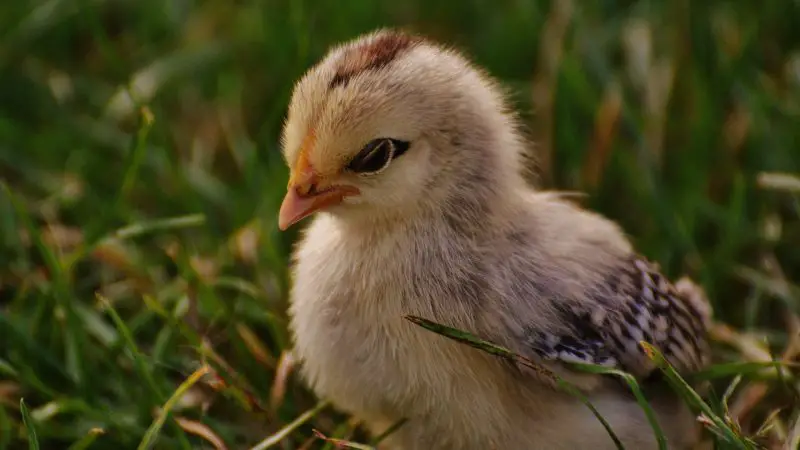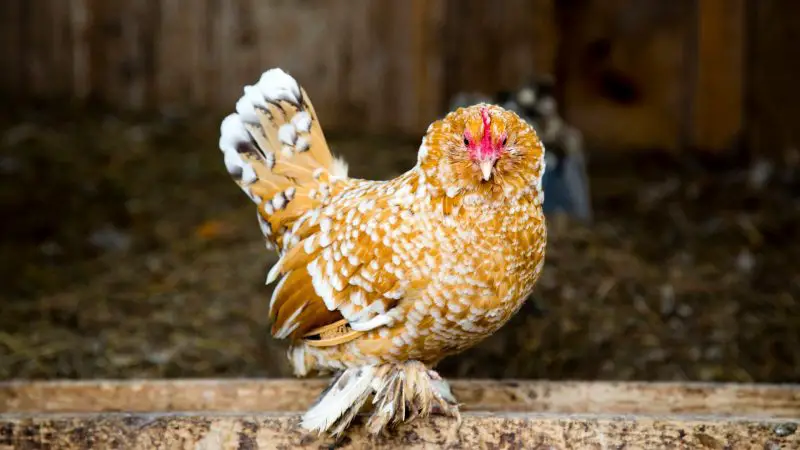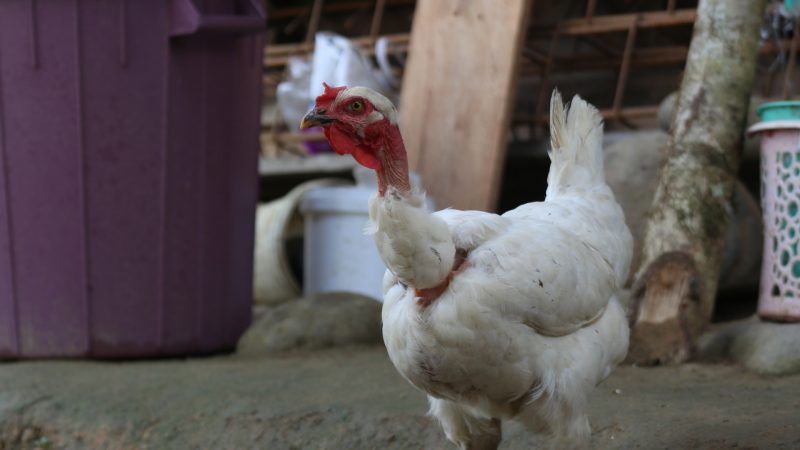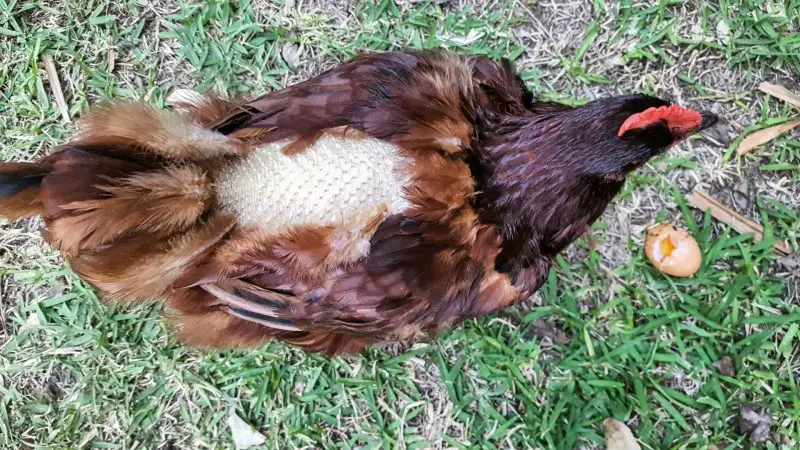When you have chickens, it can be concerning to find out that they’re losing feathers. You may wonder if it’s just a normal process or if there’s something wrong.
Why do chickens lose feathers? Chickens can lose feathers due to molting, being bullied, protein deficiencies, regular pecking during the mating process, bug infestations including lice and mites, and finally, self-pecking.
This article will be covering the reasons why chickens lose feathers, as well as lots of other relevant information about chickens and their feathers.
What Does a Fully Feathered Chick Look Like?

A fully feathered chick will look like a miniature version of a fully grown chicken. Once it’s fully feathered, the down that was previously covered should be all gone. This usually happens by the time a chick is five to six weeks old.
Notably, a chick’s first feathers will be darker than its chick down. Chick feathers range from light yellow to brown or even red, depending on the breed of chickens you have.
Most importantly, a fully feathered chick is ready to transition from its indoor brooder to an outdoor coop. By this time, they’re getting pretty big for the brooder and will need more space. Plus, they can self-regulate their body temperatures outdoors. The exception is that it shouldn’t be colder than about 50°F (10°C).
How Many Feathers Does a Chicken Have?

Smaller chickens may have as few as 5,000 feathers, while larger chickens can have as many as 8,000. This is an estimate, not an exact number. However, chickens of the same weight and size will generally have approximately the same number of feathers.
Just as with the number of feathers, the size of the feathers will vary based on the overall size of the chickens. Big chickens will have big feathers, and small chickens have small feathers. Chicks will have the smallest feathers of all.
Do Chicken Feathers Grow Back?
According to the Annual Review of Animal Biosciences, chicken feathers almost always grow back. However, the precise timing of when this happens might vary widely.
The study also discusses the in-depth biological processes behind feather growth in chickens.
Hens sometimes grow back feathers immediately, while sometimes they don’t grow back until their next molt in the late summer to fall. For the most part, a hen’s energy will be directed first toward egg production and subsequently toward regrowing lost feathers.
When Are Chicks Fully Feathered?
Chicks are usually fully feathered by the time they reach five or six weeks old. If they’re not fully feathered, it means their growth is stunted for some reason. Perhaps they aren’t getting enough food or water, or maybe the food they’re getting doesn’t have enough vital nutrients.
Why Is Your Chicken Losing Feathers Around Her Neck?
Chickens may lose feathers around their necks for various reasons, including but not limited to the following:
- Molting
- Stress from being bullied
- Protein deficiencies
- Mating
- Bug infestations, including lice or mites, and
- Self-pecking
Next, we’ll discuss what you can do to remedy these common issues and get your chicken back in healthy shape.
Molting
Chickens beginning to molt will often lose neck feathers first. This is perfectly normal, and you shouldn’t worry. It’s important during molting to provide your chicken with lots of protein and a safe, cozy nesting area with plenty of litter.
Being Bullied
Chickens have an unfortunate tendency to bully one another by plucking out each others’ feathers for various reasons like:
- Boredom
- Overcrowding
- Dominance issues
Chickens that are being bullied can be separated from the others by using chicken wire.
Also, give your chickens litter to sleep on. Chickens have a nesting instinct, and if they lack a cozy sleeping area, they will resort to pulling out each others’ feathers.
Protein Deficiency
If a chicken lacks protein in its diet, it may lose feathers.
You can remedy this by feeding chickens feed that’s high in protein. Increased protein consumption has the added benefit of increasing egg production.
Mating
Roosters can be very vicious when it comes to plucking out feathers, whether it’s their own or the feathers on hens they mate with. Sometimes, roosters pluck out all the tail feathers off a hen.
To reduce plucking, give your chickens lots of space; overcrowding stresses chickens out and can make them pluck feathers. However, it is unlikely that you will be able to entirely avoid chickens losing their feathers as a result of mating.
Bug Infestation
Lice and mites can infest chickens and cause them to lose feathers in the neck and other areas.
For best hygiene, chickens need an area to dust bathe.
To kill and prevent bugs, you can regularly spray down your chicken coop and scatter diatomaceous earth around cracks and corners. Chickens can be debugged by spraying them down with water mixed with oil and soap, and a good rinse to finish.
Self-Pecking
If a chicken is very bored or protein deficient, it may peck at its feathers. To reduce this:
- Get your chickens some durable wood branches to peck.
- Consider getting high-protein chicken feed.
- Make sure you have a litter in the coop.
With high protein and items to peck, chickens will be less apt to peck at themselves. Chickens will pluck out their feathers to make a nest if they don’t have a litter.
Related: Chickens & Goats | Simple Guidelines for Safe Coexistence!
What Chicken Breeds Have Feathered Feet?

While many chickens in North America have no feathers on their feet, lots of chicken breeds around the world have feathers on their feet that give them a cute appearance.
A few of the chicken breeds that have feathers on their feet include:
- Belgian D’Uccles
- Cochin
- Faverolles
- Brahma
- French Marans
- Pekin
Related: 9 Chicken Breeds With Feathers on Feet | How to Care For Them?
How Old Are Chicks When They Start Getting Feathers?
Chicks start getting their feathers when they’re around five days to a week old. The feathers make the chick look a little funny because they jut out from the down that initially covers the chick’s whole body. For weeks, a chick will lose its down feather until it is all gone.
What Does a Chicken Look Like Without Feathers?

Chickens that lack feathers look very peculiar, like a frozen chicken but with legs and a head. It is extremely uncommon to see a full bald chicken, although it’s not unusual to see chickens with bald spots, particularly during molting season.
How Long Does Chicken Molting Last?

During the late summer to fall months, the molting process in chickens can take 4 to 6 months to complete. Because the chicken is using much of its nutrients to regrow its feathers, a significant drop in egg production occurs during these months.
Feeding molting chickens a high protein diet can help offset this reduction in egg production. Additionally, it helps them regenerate feathers more quickly.
How to Take Care of Molting Chickens?
Molting is an uncomfortable process for chickens. So naturally, you’ll want to do everything you can to help them through it.
You can help your chickens through the molting process by doing the following:
- Increase their protein via feed or by feeding them protein-rich treats. Cooked eggs, raw worms, and tuna are all great treats rich in protein. Do not feed chickens raw eggs because that can make them get a taste for raw eggs and eat their eggs in the future. If you opt to use treats to increase protein, give them three to five times a week for best results.
- Do not give them dairy. Some people say to feed chickens yogurt, but you should not give chickens dairy. Their digestive tracts don’t have the right enzymes to digest dairy. This can make their stomachs upset and reduce further nutrient intake.
- Let your chicken eat its feathers. It’s acceptable if a chicken eats its molting feathers. Just take care that they have enough protein because this is sometimes a sign that they lack enough protein.
List of Sources
Development, Regeneration, and Evolution of Feathers
